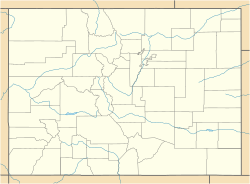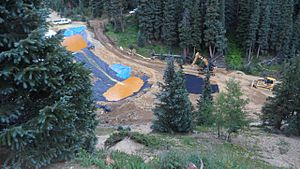2015 Gold King Mine waste water spill facts for kids
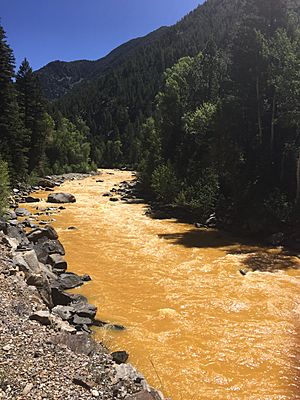
The Animas River between Silverton and Durango within 24 hours of the spill. The river turned yellow from the oxidation of dissolved iron in the escaped waste water.
|
|
| Date | August 5, 2015 |
|---|---|
| Location | Gold King Mine Silverton, Colorado, United States |
| Cause | Accidental waste water release, approx. 3 million US gal (11,000 m3) |
| Participants | Environmental Protection Agency |
| Outcome | River closures (until about Aug 17 with ongoing tests) Ongoing water supply & irrigation issues |
| Waterways affected | Animas and San Juan rivers |
| States affected | Colorado, New Mexico, Arizona, Utah |
The 2015 Gold King Mine waste water spill was a major environmental disaster. It happened at the Gold King Mine near Silverton, Colorado. Workers from the Environmental Protection Agency (EPA) and a company they hired accidentally caused it.
On August 5, 2015, they were trying to drain water near the mine's entrance. They accidentally broke a barrier holding back a lot of dirty water. This caused about 3 million gallons (11 million liters) of toxic mine waste water to spill out. This water contained heavy metals like cadmium, lead, arsenic, and copper. It flowed into Cement Creek, which leads to the Animas River. The Animas River then flows into the San Juan River and the Colorado River.
The EPA was criticized for not warning Colorado and New Mexico until the day after the spill. Even though an EPA employee knew there was a risk of a "blowout," warnings were delayed. The EPA took responsibility for the accident. However, they initially refused to pay for damages, saying the government couldn't be sued without special permission. Colorado's Governor declared the area a disaster zone. The spill affected rivers in Colorado, New Mexico, and Utah, including the Navajo Nation. This event brought attention to pollution from many other old, abandoned mines across the country.
Contents
Understanding the Mine Spill
History of Gold King Mine
Gold mining was very important for the Silverton area's economy. This lasted until 1991, when the last mine near Silverton closed. The Gold King Mine itself was shut down in 1923. Before this spill, the Animas River basin already had no fish. This was because of pollution from mines like Gold King. Other plants and animals in the area were also harmed by mine waste.
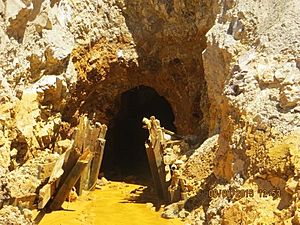
Many abandoned mines in Colorado have problems with "acid mine drainage." This happens when metal minerals like pyrite are exposed to water and air underground. This creates acidic water that can harm rivers and the animals living in them. At the time of the accident, the EPA was working at Gold King Mine. They wanted to stop the leaking water from flowing into Cement Creek.
Water was building up behind a plug at the mine's entrance. The EPA planned to add pipes to slowly release and treat this water. They wanted to do this before the water built up enough to burst out. But the workers didn't know that the mine tunnel behind the plug was already full of water under high pressure. The water burst through the plug soon after they started digging.
In the 1990s, parts of the Animas River were considered for a Superfund cleanup. A Superfund site is a place with dangerous pollution that needs a big cleanup. But local communities didn't want it to be listed. They worried it would hurt tourism, which was their main source of money. Because of this, the EPA could only do small jobs to fix the mine's environmental problems.
Earlier Cleanup Efforts
For many years, the Gold King Mine's tunnels were mostly dry. This was because water was draining out through another mine called Sunnyside Mine. But Sunnyside Mine closed in 1991. As part of a cleanup plan, its main tunnel was sealed in 1996. After this, new polluted water started flowing from Gold King Mine in 2002. The flow increased even more after another nearby mine was sealed in 2003.
By 2009, the Gold King Mine was considered one of Colorado's worst acid mine drainage sites. In 2009, a state agency plugged the mine's openings with old mine material. They also put in drainage pipes to stop water from building up. But it was noted that these pipes might not be enough to prevent a future blowout.
In 2014, the state asked the EPA to reopen and fix the Gold King Mine opening. The drainage system hadn't been maintained since 2009. Workers saw water seeping out about 6 feet (1.8 meters) above the tunnel's bottom. They thought this meant there was 6 feet of water backed up inside. They decided to wait until 2015 to dig, so they could build a large pond to treat the water.
How the Spill Happened
The EPA team returned in July 2015 to continue their work. They found that a landslide had covered the drainage pipes. After clearing the slide, they again saw water seeping out at about 6 feet above the mine entrance. They still believed this was the level of water inside.
Their plan was to dig down from the top of the mine tunnel to what they thought was the water level. Then, they would put a pipe through to drain the water. The state and EPA agreed on this plan. However, they had misjudged how much water was actually in the tunnel.
Around 10:51 AM on August 5, the digger operator saw clear water spray out of a crack. This showed that the mine tunnel was completely full of water under high pressure. The plug broke within minutes, causing an uncontrolled release. The rushing water washed out the road leading to the site. If the EPA had drilled into the mine from above to measure the water level, they would have known the true amount of water. This would have changed their plan, and the disaster might not have happened.
Impact on the Environment
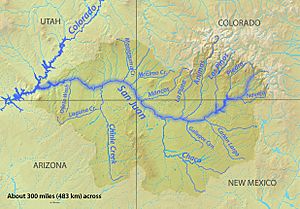
The impact on the Animas River was immediately clear. A journalist described the water as looking like "Tang that has been maybe mixed too thickly." The river was closed for fun activities until August 14. During this time, officials told people to stay out of the water. Residents with wells near the river were told to test their water before using it. People were advised to avoid touching the river, keep their pets away, and stop farm animals from drinking the water. They were also told not to catch fish. The Navajo Nation declared a state of emergency because of the spill's terrible effects on their land.
People living along the Animas and San Juan rivers were told to test their water before using it for cooking, drinking, or bathing. The spill caused big problems for farmers and ranchers who depend on these rivers for their farms. The long-term effects of the spill are still unknown. The acidic mine water temporarily turned the river orange.
By August 7, the polluted water reached Aztec, New Mexico. The next day, it reached Farmington, the largest city affected. By August 10, the waste reached the San Juan River in New Mexico and Shiprock (part of the Navajo Nation). At that time, there were no reports of people getting hurt or animals dying. The heavy metals seemed to be settling to the bottom of the river. They are mostly not soluble unless the whole river becomes very acidic. The polluted water reached Lake Powell by August 14 and was expected to pass through within two weeks.
Utah's water quality division said that the remaining pollution would be diluted. This means it would spread out and become less harmful further downstream. By August 11, pollution levels in Durango returned to normal. By August 12, the main part of the polluted water was no longer visible because it had spread out and mixed with river sediment.
Heavy Metals in the Water
On August 10, 2015, the EPA reported that levels of six metals were too high for drinking water. Some metals were found at hundreds of times the safe limit. For example, lead was 100 times the limit, and iron was 326 times the limit. Arsenic and cadmium were also above safe levels. These measurements were taken about 15 miles (24 km) upstream from Durango.
In 2018, experts reported that the spill had "further limited aquatic life." However, they also noted that the Animas River naturally had high levels of metals even before mining began. This natural pollution already limited fish and other aquatic life downstream from Silverton.
Government Actions and Response
Files obtained by the Associated Press showed that U.S. government officials knew there was a risk of a "blowout" from the mine. A work order from June 2014 stated that conditions could cause a "blowout" of polluted water. An action plan from May 2015 also mentioned the possibility of a blowout. An EPA spokesperson could not say what safety steps the EPA took.
EPA's Role in the Aftermath
After the spill, EPA supervisors were not contacted by the contractors for an hour. There was no press release informing the state until around midnight that day. Residents were not directly told about the spill until 24 hours after it happened. By then, some people might have used the river water. The water had higher levels of metals than safe drinking standards. It took weeks for the water to be considered safe for people to use again.
Right after the spill, the EPA first guessed that less polluted water had drained into the river than actually did. They also avoided questions about water tests. An EPA administrator did not visit the Silverton, Colorado, area until a week after the spill.
Another Spill in 2018
In July 2018, more waste water spilled into the river near the Gold King Mine. This happened when an EPA employee was driving a truck carrying nine cubic yards of sludge. All of it spilled into the water. The EPA did not respond to questions from the press about this incident. This sludge was supposed to go to the EPA's treatment plant for waste water. However, the plant was running out of space to store the sludge, and new storage areas are being built.
Help for Affected Communities
The Gold King Mine spill harmed the Navajo Nation's crops, home gardens, and cattle. The Navajo Nation stopped using water from the San Juan River for irrigation on August 7, 2015. While a nearby county lifted its water ban on August 15, the President of the Navajo Nation, Russell Begaye, kept the ban until August 21. This was after the Navajo Nation's own EPA finished testing the water. During this time, the U.S. EPA delivered water to the Navajo Nation.
About 2,000 Navajo farmers and ranchers were directly affected by the closing of the canals. Water was trucked in for fields, but many home gardens and some distant farms did not get help. They suffered widespread crop damage.
The EPA and the Navajo Nation are still discussing how to fairly pay the Navajo for the damage. As of April 2016, the Navajo Nation had received $150,000 from the EPA. This was only 8% of the costs the Navajo Nation had to pay. Senator John McCain estimated the Navajo Nation could face up to $335 million in costs from the spill.
Lawsuits for Compensation
Several lawsuits have been filed against the EPA because of the Gold King Mine spill. New Mexico is asking for $130 million, Utah is seeking $1.9 billion, and the Navajo Nation is also asking for $130 million.
At first, the EPA told affected people to file claims for damages. However, they changed this in January 2017. The EPA is now trying to get all lawsuits dismissed. They say they have already spent enough money ($29 million) to clean up the Animas River and other polluted areas. EPA officials claim they have legal protection and do not owe more money.
|


